Osprey Porter 46 Review
For better or worse, the Osprey Porter 46 is a big pack with a big capacity. Bulk it up or cinch it down, the Porter is a durable option for those who tend to carry more.
Our Verdict
Save time. Get access to brief summaries of our reviews so you can browse and make decisions more efficiently.
Pros
- 46 liters = more room for stuff (we’ll let you decide whether that’s a good or bad thing)
- Roomy, cube shaped clamshell is ideal for packing cubes
- Compression straps diminish the bag’s bulkiness when not packed full
Cons
- Broad shape—tough to pull off if you have narrow shoulders
- Very little organization within the main clamshell
- A bit boxy and clunky to navigate in tight spaces when packed to capacity
Technical Details
-
Capacity
46l
-
Weight (lb)
3.4 lb (1.5 kg)
-
Dimensions
22 in x 14 in x 9 in (55.9 x 35.6 x 22.9 cm)
-
Notable Materials
Nylon
-
Manufacturing Country
Vietnam
-
Laptop Compartment Size
15"
-
Warranty Information
Buying Options



Full Review
Intended to be a hybrid between a duffel and a backpacking bag, we’ve found Osprey’s Porter 46 to be a little more akin to a suitcase on your back—which isn’t necessarily a bad thing. If you can overlook the pack’s bulkiness when full, you’ll have yourself an incredibly durable and roomy bag that can comfortably accommodate longer one-pack trips. Plus, you can always compress it down when lugging less.
Materials & Aesthetic
The first thing we noticed about the Porter? It’s a big son-of-a-gun. At 46 liters, we shouldn’t have been all that surprised. The most notable quality of the bag is its broad and bulky box-like shape—when full, it’s basically as if you’ve attached straps to a standard roll-aboard and slung it on your back. It helps when you cinch it down with the compression straps, though it still ends up looking like a pretty hardcore travel bag.
Fair warning: those with a smaller frame could potentially be dwarfed by it.
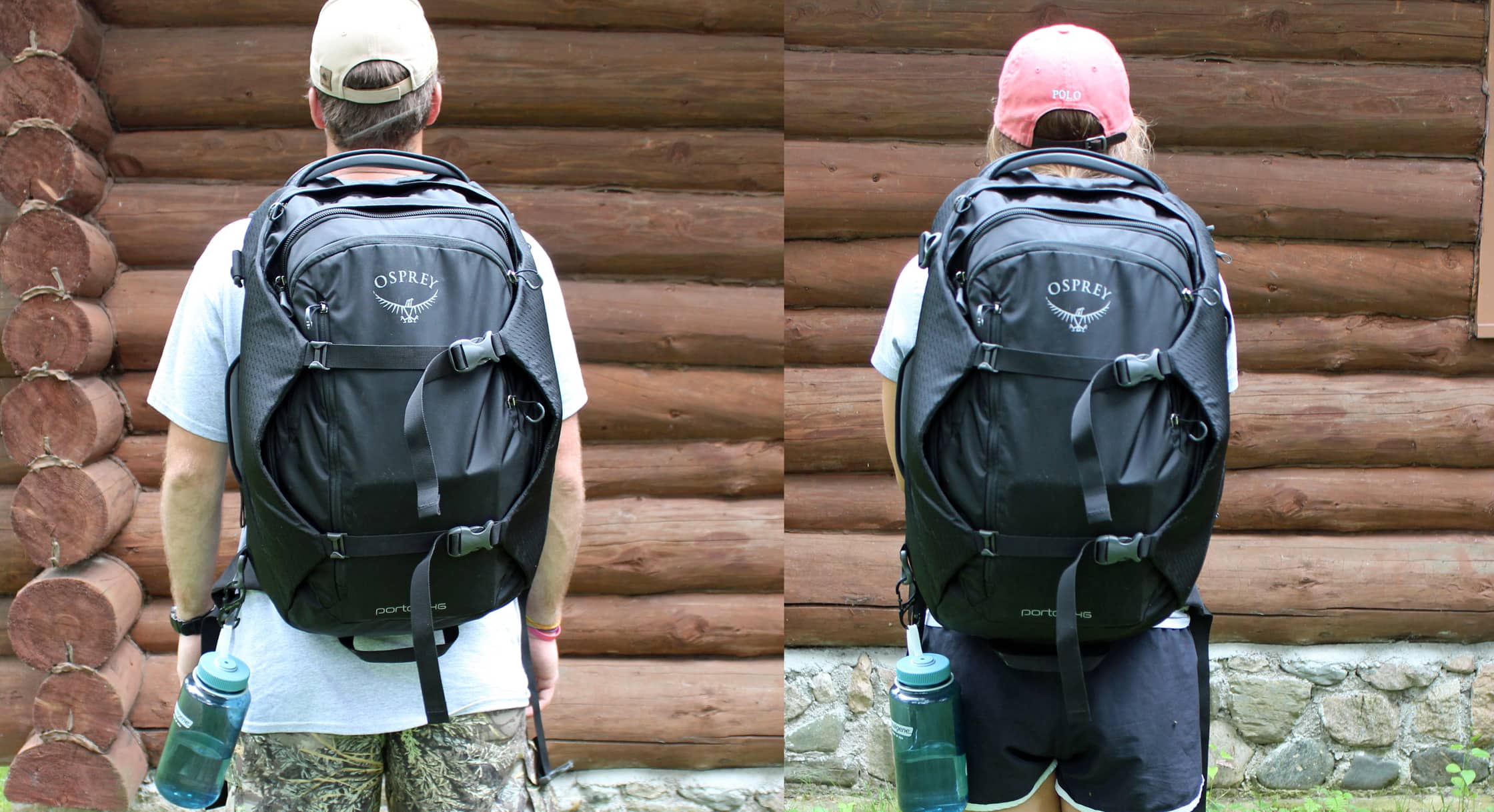
The main part of the Porter is made with 420HD nylon packcloth and the wraparound sides and bottom are a 420D nylon wave ripstop. The squiggly design of the ripstop contrasts with the unaccented packcloth of the rest of the bag—which is fun and different without being too fun and different.
Speaking of not being fun and different, we chose the black version of this bag (*sarcastic gasp*). The Porter also comes in diablo red, castle grey and mineral teal. It’s worth pointing out that the folks at Osprey didn’t feel the need to add a meaningless adjective for “black” and left it at just that—know your consumer, it obviously worked on us.
The Osprey branding on this pack isn’t the most egregious we’ve ever seen, but it is there spreading its funky little stick bird wings. There’s also a “Porter 46” call out toward the bottom of the pack in a nifty modern typeface.
External Components
One of our favorite features on this bag is the padded side, top and bottom handles. These suckers are sturdy—great for flinging in and out of overhead bins or at oncoming pigeons trying to sample your macaroons. Also on the side are two durable D-rings, should you decide to attach a strap (sold separately) and carry it like a duffel. We haven’t tested this yet, but found the rings useful for attaching carabiners.
Another handy feature of the Porter is the option to stow away shoulder and waist straps when not in use—similar to what we found while reviewing the Osprey Farpoint and Fairview packs (more on that later). Along the upper middle of the pack’s backside (the side that literally touches your back) is a horizontal zippered compartment that spans the width of the bag. This is where you can stow the shoulder straps.
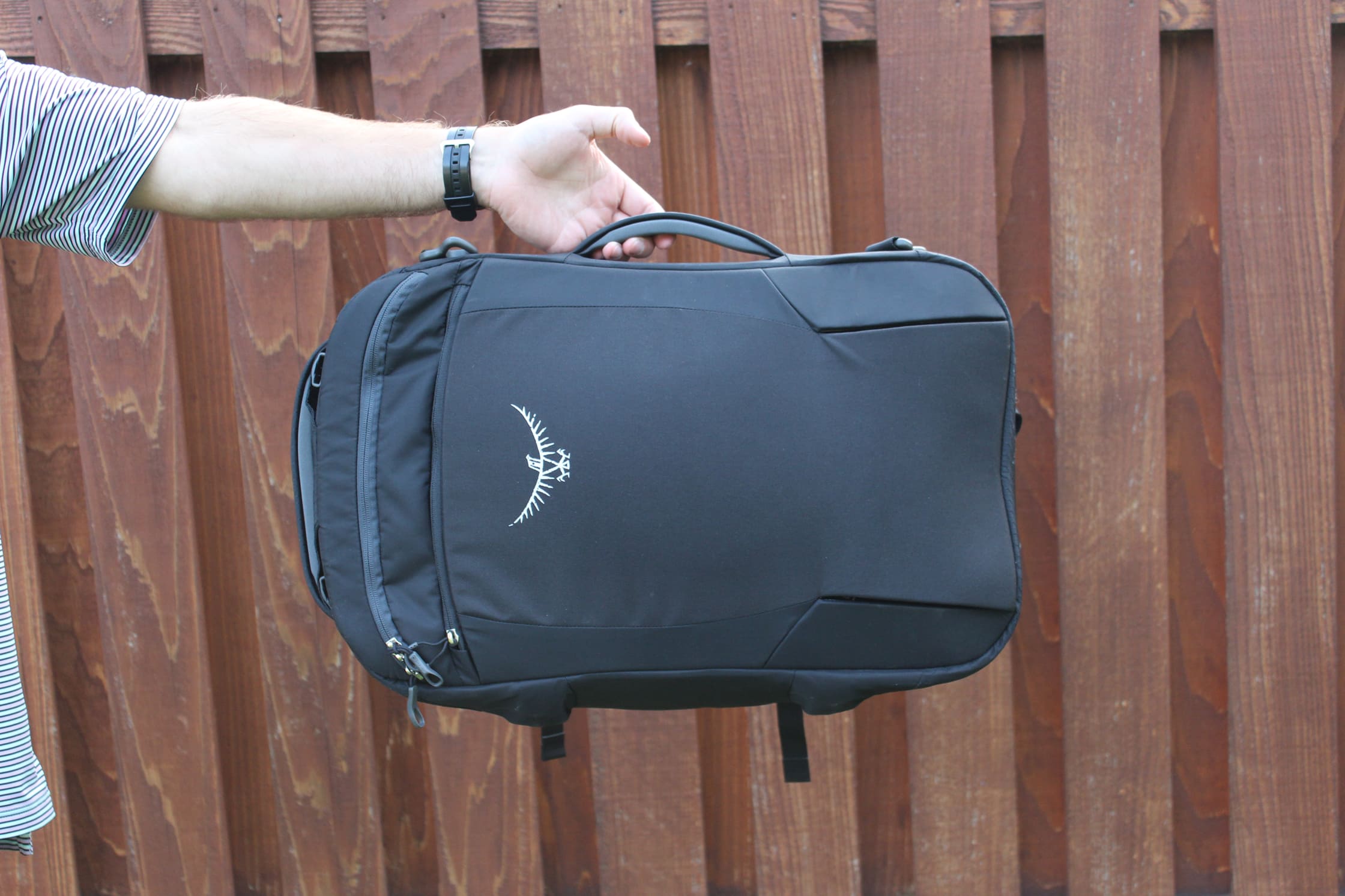
The waist strap is folded over and tucked into an unzippered pocket at the bottom. The buckles to attach the bottom of the shoulder straps are also tucked into this pocket—knowing this will keep you from looking around like an idiot for five minutes upon first unloading the straps (we selfishly did this so you don’t have to).
The shoulder and hip belt are both comfortably padded—especially the waist strap. The sternum strap is pretty standard as far as those go, and all of the pulls adjust with minimal effort on-the-go. You can easily lug a decently heavy pack around for a full day of travel without back or shoulder discomfort, thanks to the padded straps and ability to easily redistribute the weight.
Now back to those nifty compression straps we mentioned earlier. Along the front of the pack are two buckled straps connecting the padded ripstop sidewalls. Osprey coined this “StraightJacket Compression,” a pretty spot-on description for how the technology works. Though the straps won’t totally shrink the bulkiness, the ability to cinch down will minimize it for a more discreet carry when the big isn’t packed to the brim.
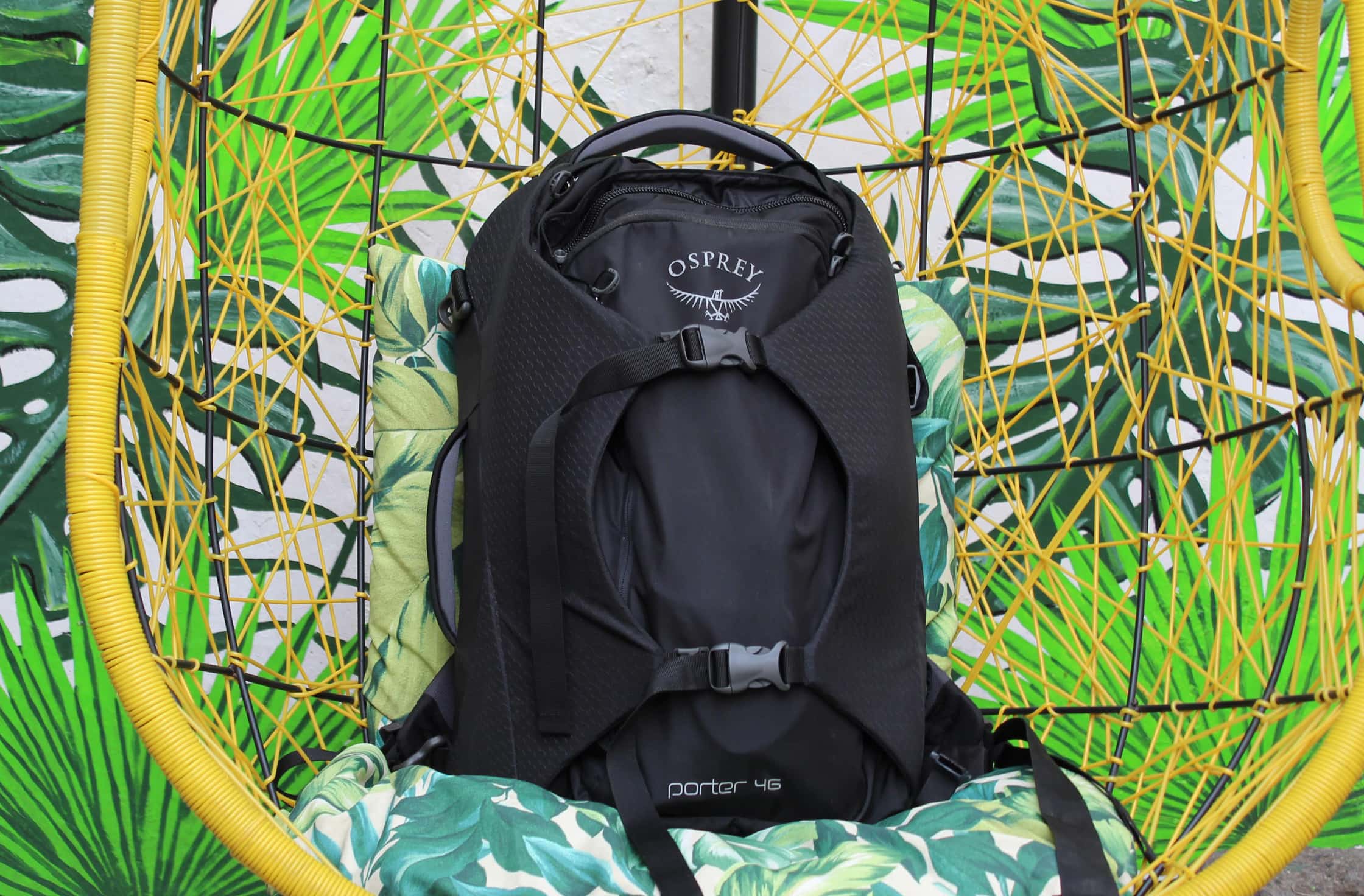
The YKK zippers and buckles are heavy duty—the large plastic pulls on the zippers are significantly easier to grab than the standard metal ring. The main and laptop pockets both feature lockable zips, yay security.
Inside the Pack
Speaking of pockets, the Porter has a solid variety of external compartments for quick access while traveling. The pocket at the top is described by Osprey as an easy access point for toiletries or liquids while traveling, but we’ve found it also works well for stowing a phone, wallet, passport, phone charger, and just about any other small miscellaneous item you might need in a pinch.
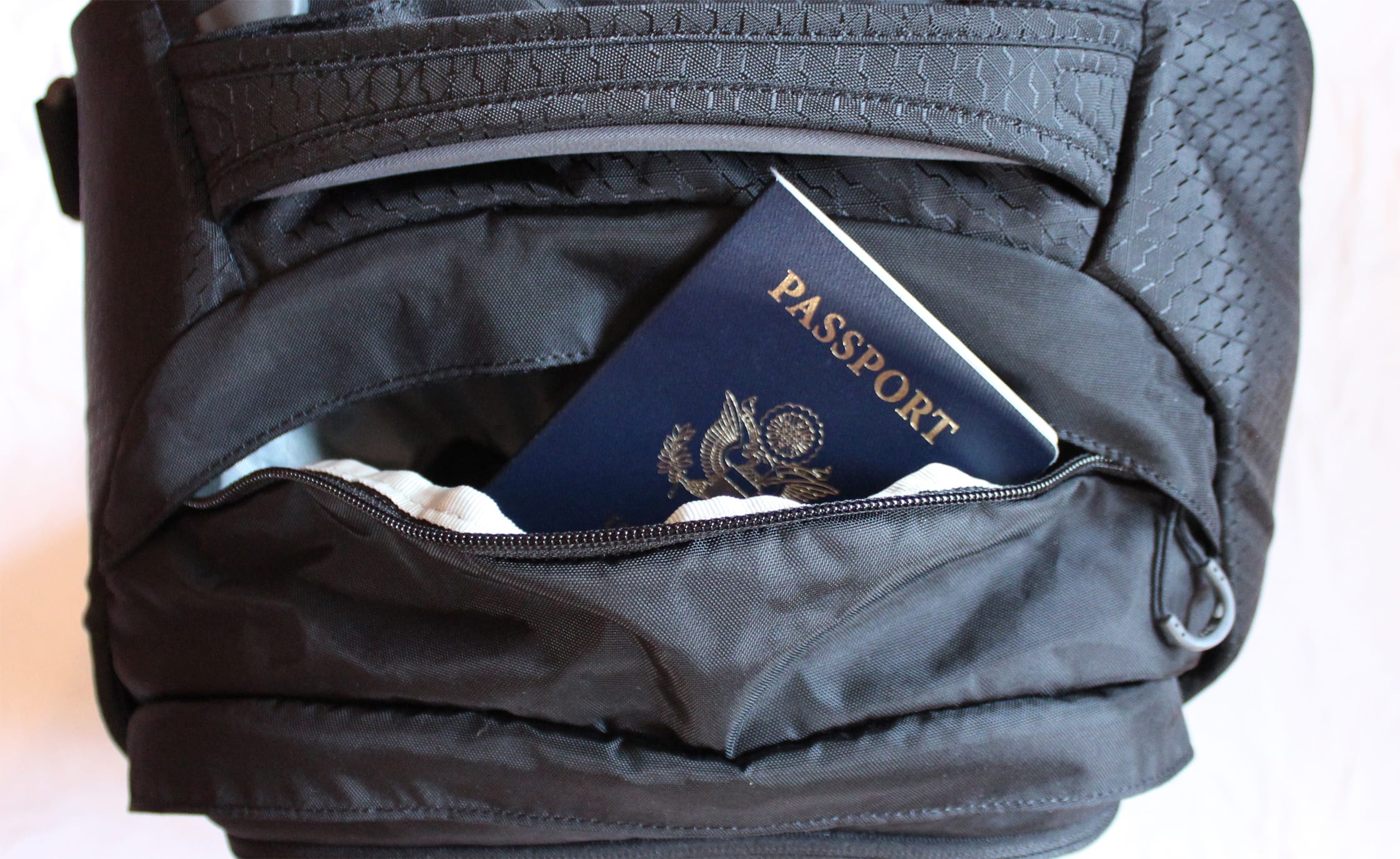
There are also two pockets along the front of the pack. The larger of the two is incredibly well-organized with a zippered mesh pocket (good for keeping cords separate) and designated areas for phones, pens, and other things. We were surprised by how much this pocket expanded, adequately accommodating a two-inch book and full-sized notebook with room to spare. The third pocket runs vertically down the front of the pack and, though not the most spacious, it’s another great spot for quick-grab items or travel documents.
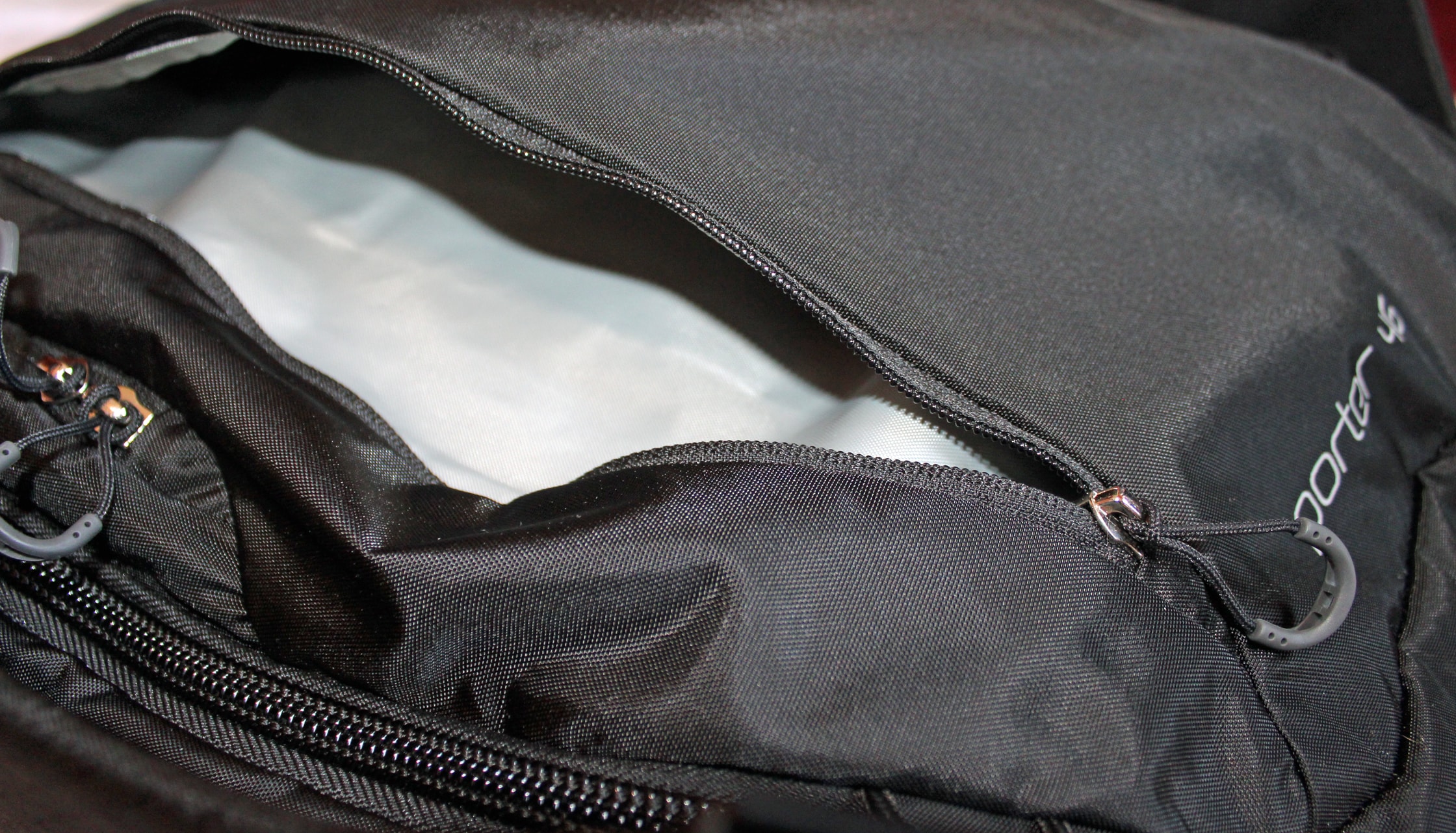
The padded laptop sleeve is along the backside of the pack. Having this designated pocket both keeps your device protected and makes it relatively quick to take out on those days the TSA decides to make your life harder. You shouldn’t be able to feel your laptop through the back of the pack when it’s on but, if you do, it’s probably better for your posture anyway. The sleeve also has a handy zippered mesh pocket for things like charging cords, headphones or battery packs.
The spacious main clamshell opens via a u-zip from the top of the pack. The roomy, cube-like rectangular clamshell looks a lot like the inside of a roll-aboard carry-on—an impressive feat for something you sling on your back. It looks like it fits quite a bit and you’ll soon find it fits even more. Thickly padded side walls mean added protection for both your gear and your body.
We highly recommend packing cubes as they fit snugly into the corners of this boxy clamshell—they also will give you some semblance of organization in a space that contains virtually none. The only organizational features comes in the form of one zippered mesh pocket and one standard zippered pocket, each lining one of the vertical side walls. We found these side pockets did the trick for keeping already-worn clothes away from the clean stuff—although they won’t fit all of your stinky stuff, so you’ll have to prioritize.
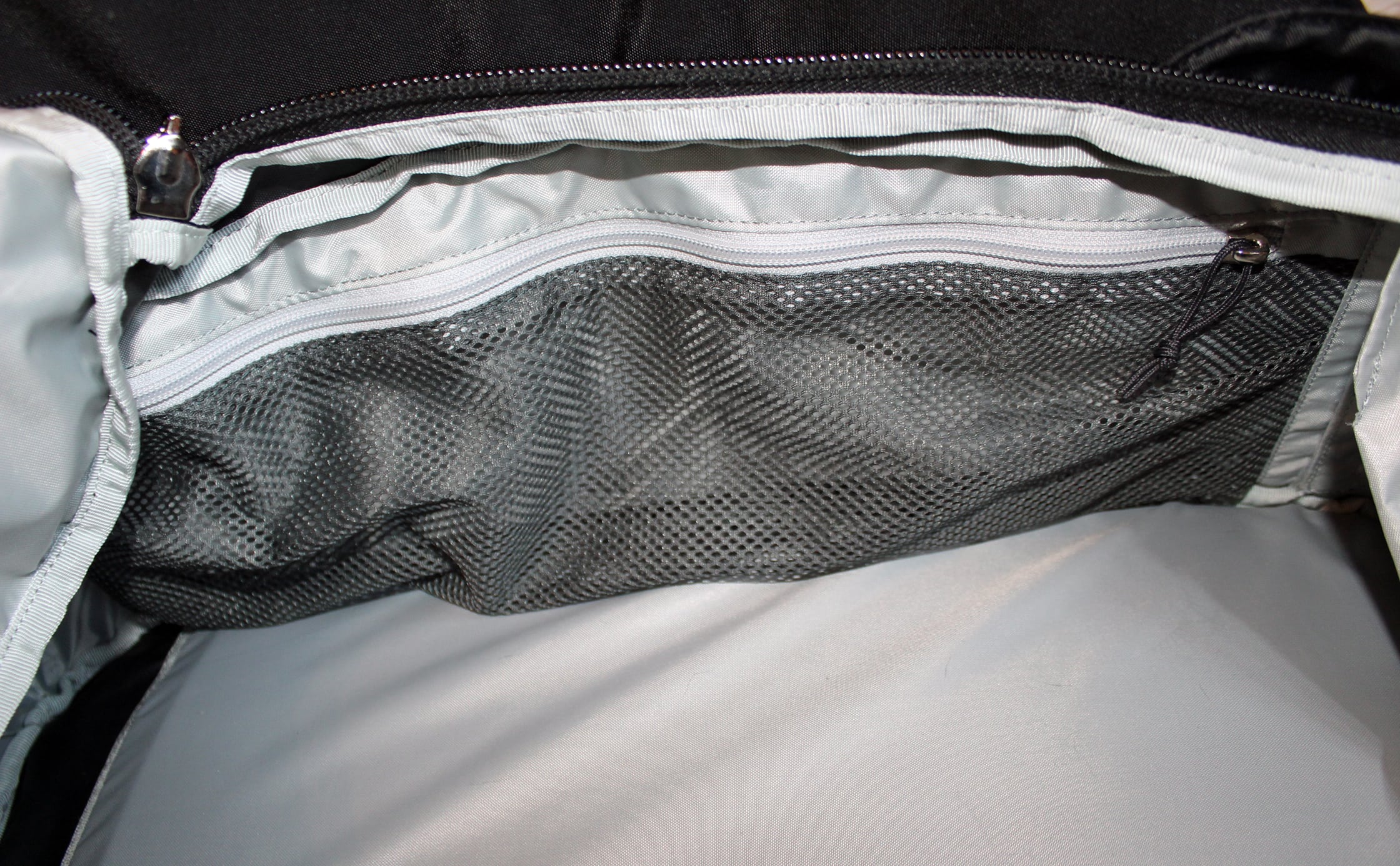
Durability & Testing
As mentioned before, we were genuinely shocked at how much fit inside this pack. It managed to handle everything for a nine-day trip to Guatemala with ease. And even when you think it’s at capacity, you’ll find corners to squeeze in even more. At one point, this thing was filled with 3 packing cubes, a DSLR (inside a soft case), two travel towels, rain jacket, tennis shoes, and a travel pillow.
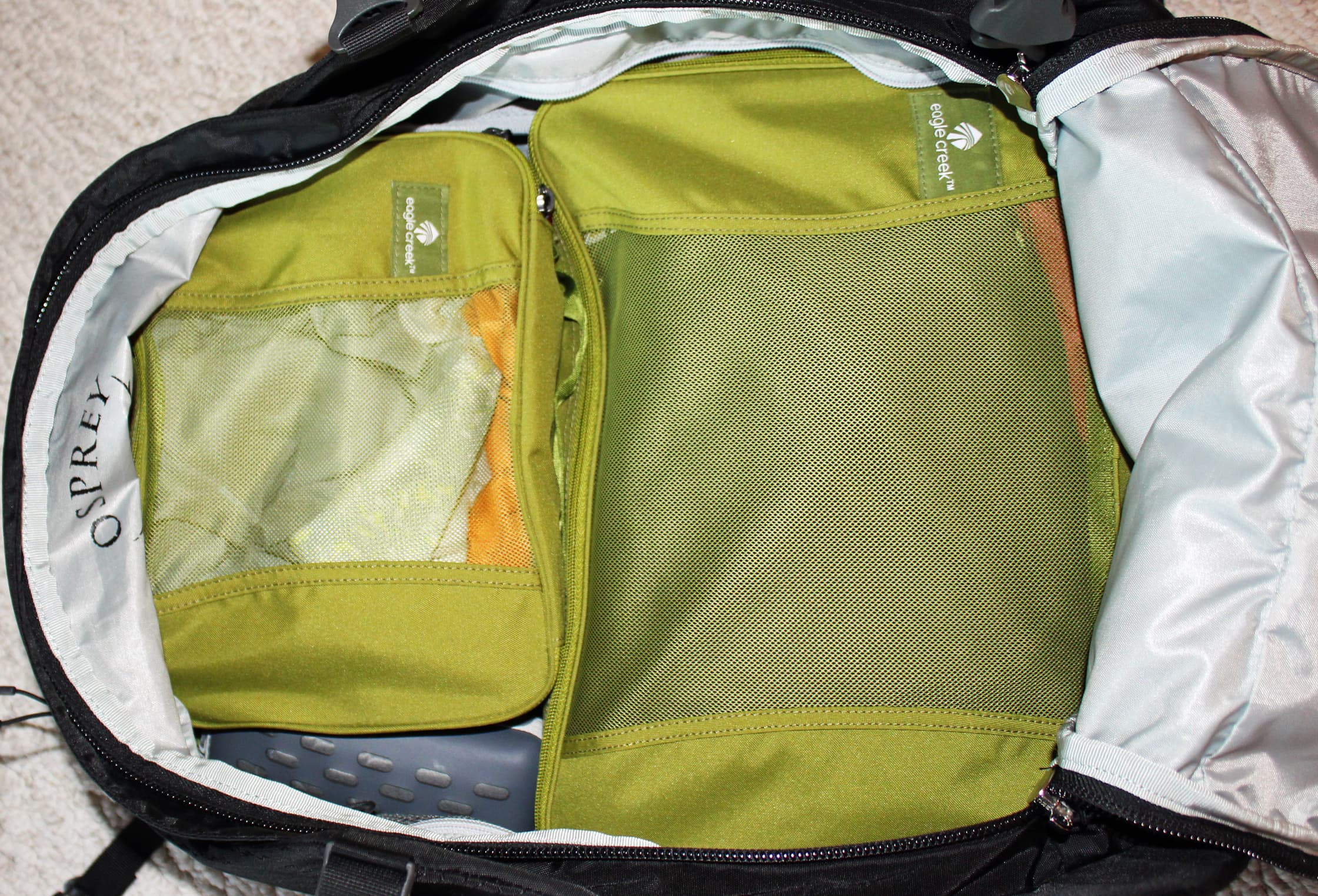
We have to mention that once you stuff this pack full it’s a bit of a challenge to navigate tight corners and crowds. It’s also not super conspicuous—we heard more than one comment along the lines of “Woah, that’s a travel bag if I’ve ever seen one.” In addition to being a full 46 liter pack, we presume the stiff and cube-like appearance also contributed to that vibe. The bag sits pretty high on your back and you’ll want to be sure the weight is well-distributed (with your heaviest stuff closest to your back in the middle). The sternum straps and waist straps are a back-saver when hauling heavier cargo—huge bonus that the sliders are easy to adjust when on the move.
We’ve found the top exterior pocket to be most useful on the go as it is easiest to drop a strap, swing to the front and access. The lack of a water bottle pocket (or anything that could double as one) is definitely a bit of a disappointment, but not the end of the world. The best alternative we’ve come up with is clipping the bottle to a carabiner around a D-ring on the side of the pack.
When it comes to lugging a full Porter onto an airplane, we haven’t had any trouble stowing it in the overhead bins. The frame is probably still too big and bulky to fit under a seat, even if you took everything out of it. Some folks online claim the Porter exceeds regulation size for some flights, so you’ll want to double check (though we’d be surprised if any major airlines denied it).
While the stiffness doesn’t do a lot for the Porter’s aesthetic, it does make us confident this bag is going to provide more than adequate protection for any valuables. Thus far, we haven’t had any concerns about this pack withstanding the elements (well, except for heavy rain—it’s not waterproof).
Porter vs. Farpoint/Fairview
It only makes sense to compare this bag to the Osprey Farpoint and Fairview backpacks. As a quick refresher, the Farpoint is Osprey’s best-selling travel pack and the Fairview is the same concept designed with women in mind. For simplicity (and laziness) sake, we’re going to refer to them as “the Fs” for the rest of this review.
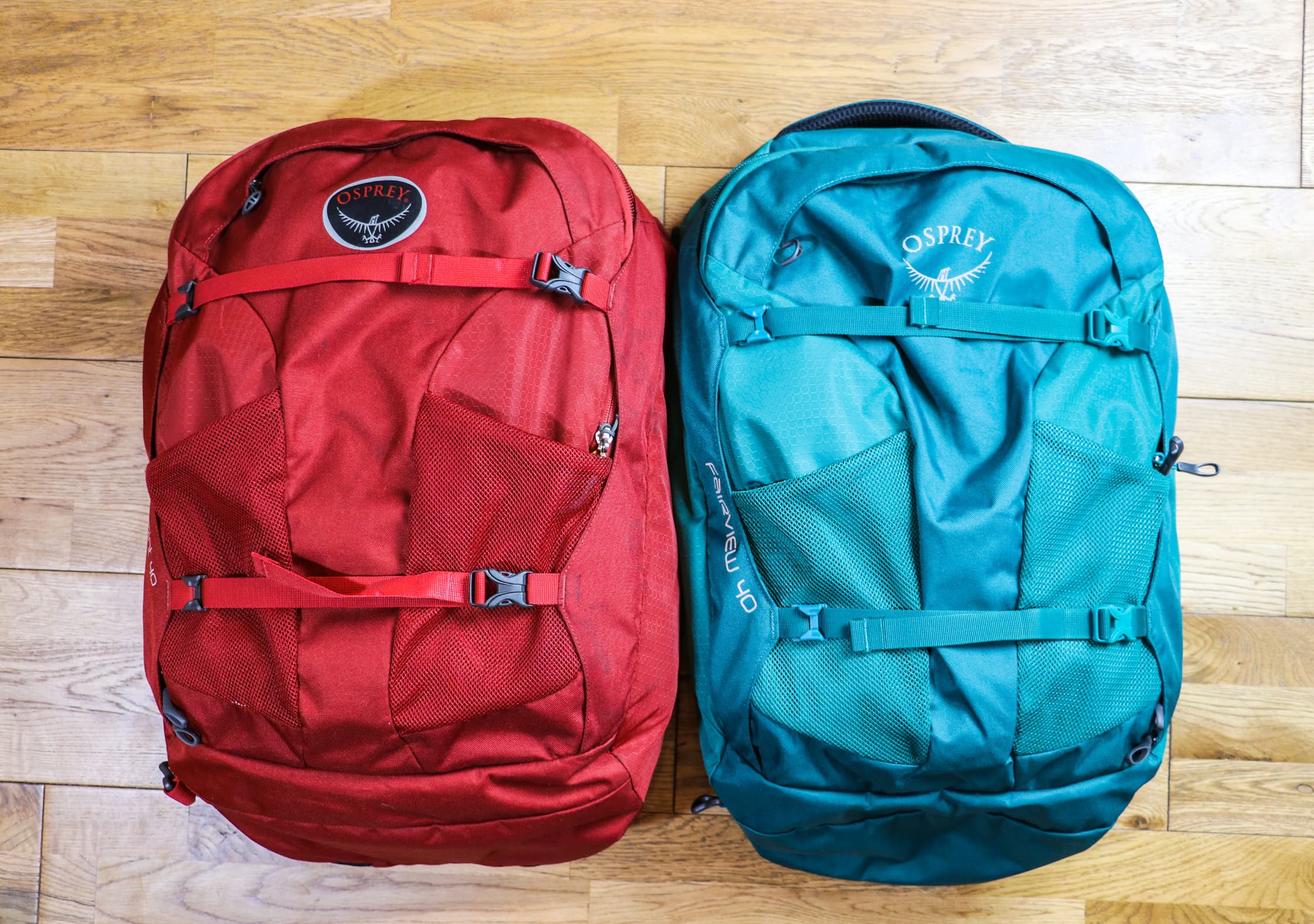
The primary difference is size—compared to the 46L Porter, the Fs are only 40 (which, for the record, is still a lot). The design of the Fs is a bit more outdoorsy than the more sleek look of the Porter. And while all three are very clearly travel bags, the Fs look more “backpacky” and less “suit-case-on-your-back-y.”
Many of the bag features are the same, including the nifty stowaway pockets for the straps and padded side handles. Though not included with the Porter, the Fs come equipped with the shoulder bag strap for those who want to give the duffel-look a go. The clamshell on the Porter is a bit more square—which, again, is probably better for packing cubes. All of the clamshells have separate mesh compartments but, as opposed to the side pockets on the Porter, the Fs have a larger single pocket on the other side of the clamshell compartment.
Another major difference between the two bags is laptop storage. The laptop compartment on the Fs is inside of a front pocket, unlike the Porter’s pocket along the backside which does provide better weight distribution and protection. Whereas we needed to get creative with a carabiner on the Porter, the Fs have handy mesh compartments on the front of the pack for stowing water bottles and other non-valuables.
When it comes to choosing one over the other, it’s probably first and foremost a matter of your preference on design and feel. The Fs look even more like travel bags than the Porter, but don’t have as much bulk. Though the Porter comes with an extra six liters, the Fs are definitely large enough for the standard traveler and, aside from the laptop compartment, most of the other pack features are on par with one another.
Usage Timeline
Condition: Excellent
Looks sharp out of the package. Impressed with the padding and how much we can fit inside. Stowaway pocket for straps are a nifty feature, though it took us a few minutes to figure out what tucks where.
Condition: Excellent
Comfortable to wear for extended periods and we continue to be surprised at how much this pack can hold.
Condition: Excellent
No signs of wear, still holding up like the beast that it is.








Get your questions about the Osprey Porter 46 answered from our team and the Pro Community right here on the page. Plus, join discussions with other members about gear, guides, and more.
Join Pack Hacker Pro or, Sign In